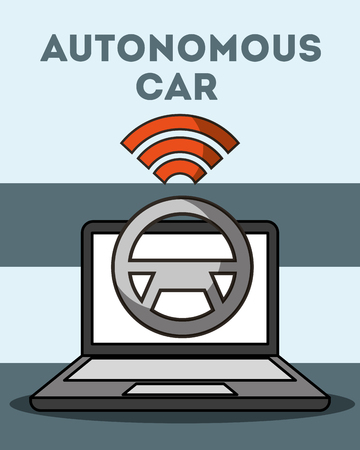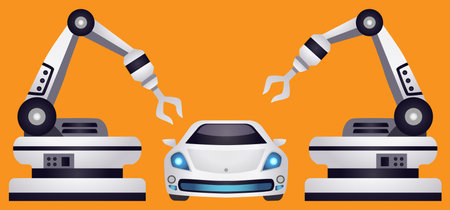Introduction: Shaping the Driving Experience
Artificial Intelligence is quickly transforming the way Americans interact with their cars. Gone are the days when vehicles were just a means of getting from point A to point B. Today, AI is ushering in a new era where your car understands your preferences, adapts to your habits, and even anticipates your needs before you do. From voice assistants that remember your favorite playlists and routes, to safety features that adjust based on your driving style, AI-powered personalization is setting a new standard for what we expect from our vehicles. As this technology evolves, drivers are experiencing a level of comfort, convenience, and connection that once sounded like science fiction but is now becoming part of everyday life on American roads.
2. Personalized In-Car Environment
As artificial intelligence continues to evolve, the concept of a truly personalized in-car environment is becoming a reality for American drivers. Imagine stepping into your vehicle and having everything set up just the way you like it—no more fiddling with controls or adjusting settings every time you get behind the wheel. AI-driven systems are now capable of learning your individual preferences and habits, transforming your daily commute or road trip into a uniquely tailored experience.
How AI Customizes Your Drive
AI-powered customization goes far beyond simple memory seat functions. Advanced sensors and data analytics work together to monitor your behaviors over time, including preferred temperature settings, favorite playlists, ideal seat positions, and even lighting preferences. The system then proactively adjusts these elements as soon as you enter the car—or even before, via remote app connectivity.
What Can Be Personalized?
| Feature | How AI Personalizes |
|---|---|
| Climate Control | Automatically sets temperature and fan speed based on your past choices and outside weather conditions. |
| Seat Positioning | Remembers multiple driver profiles, adjusting seat height, lumbar support, and steering wheel angle automatically. |
| Ambient Lighting | Selects color and brightness based on time of day, mood, or previous user selections. |
| Infotainment System | Curates music, podcasts, and news according to listening history and current activity (commuting, road trips, etc.). |
The American Touch: Convenience Meets Comfort
This level of personalization speaks directly to the American love for convenience and comfort. Whether youre cruising down Route 66 or navigating city traffic, AI ensures that your in-car environment feels familiar and comfortable every time. Plus, with voice assistants like Alexa Auto or Google Assistant integrated into many new vehicles, making real-time adjustments is as easy as saying what you want—no distractions required.
In short, AI-driven in-car personalization isnt just about luxury; its about enhancing safety, reducing driver stress, and making every journey feel more like home. As these technologies become standard features in more vehicles across the U.S., expect a new era where your car truly knows you.

3. AI-Driven Safety and Assistance
When it comes to the future of vehicle personalization and user experience, safety is a top priority for American drivers and passengers. Thanks to rapid advancements in artificial intelligence, our cars are getting smarter—and safer—every year. Modern vehicles now feature AI-powered systems that go far beyond traditional airbags and seatbelts.
Smart Warnings That Learn From You
AI-driven warning systems can analyze your driving habits and environmental conditions in real-time. For example, lane departure warnings and forward-collision alerts use sensors and machine learning to detect potential hazards before you even notice them. These systems can adapt over time, learning when youre most likely to get distracted or tired, and offer timely reminders tailored specifically to you.
Real-Time Monitoring Keeps Everyone Protected
AI doesn’t just watch the road—it keeps an eye on the driver too. Advanced monitoring tools can track signs of fatigue, distraction, or even sudden health issues like drowsiness or microsleep episodes. If the system detects anything unusual, it can trigger alerts or even intervene by slowing down the vehicle.
Adaptive Cruise Control for Smooth and Safe Rides
Adaptive cruise control is another standout feature powered by AI. Unlike basic cruise control, this smart technology adjusts your car’s speed based on traffic conditions, maintaining a safe distance from other vehicles automatically. This not only makes long highway drives less stressful but also reduces the risk of rear-end collisions.
Accident Prevention That Goes the Extra Mile
The latest AI systems are designed to predict and prevent accidents before they happen. By analyzing data from cameras, radar, and other sensors, these tools can identify risky situations—like a pedestrian stepping into the street or a car suddenly braking ahead—and take immediate action such as applying emergency brakes or steering corrections.
In short, AI-driven safety features are quickly becoming essential for anyone who values peace of mind behind the wheel. As these technologies continue to evolve, we can expect even greater levels of protection and personalized assistance every time we hit the road.
4. Voice Assistants and Natural Interaction
As AI technology evolves, voice assistants are becoming a game-changer in vehicle personalization and user experience across the U.S. With advanced AI voice recognition and conversational interfaces, drivers can now interact with their cars in ways that feel as natural as talking to a friend. This shift isn’t just about convenience—it’s about making driving safer, more intuitive, and hands-free.
The Power of Advanced Voice Recognition
Modern vehicles equipped with AI-powered voice assistants understand American accents, slang, and regional dialects, delivering reliable responses even amidst road noise or music. These systems are designed to process commands quickly and accurately, helping drivers stay focused on the road. Here’s how advanced voice technology is transforming key aspects of vehicle control:
Feature |
Traditional Method |
AI-Enhanced Voice Assistant |
|---|---|---|
| Navigation | Manual input via touchscreen or buttons | “Hey car, take me to the nearest Starbucks” |
| Climate Control | Knobs and dials adjustment | “Set temperature to 72 degrees” |
| Entertainment | Tuning radio or scrolling playlists by hand | “Play my workout playlist” or “Tune to NPR” |
| Communication | Picking up phone or using steering wheel buttons | “Call Mom” or “Read my last message” |
Conversational Interfaces: Beyond Simple Commands
Unlike earlier systems that required specific phrases, today’s AI-driven assistants engage in natural conversations. You can ask follow-up questions like “How long until we get there?” or request real-time updates about traffic conditions without taking your hands off the wheel. The result? A smarter, safer drive that feels uniquely tailored to each driver’s preferences.
What This Means for American Drivers
This seamless integration of voice technology in vehicles means less distraction and more personalization. Whether you’re navigating downtown LA traffic or setting the perfect road trip vibe on Route 66, AI-powered voice assistants help you keep your eyes on the road and your mind at ease—making every journey smoother and safer for everyone.
5. Integration with Digital Lifestyles
One of the most exciting aspects of AI in vehicle personalization is how smoothly it can connect your car to your daily digital life. Imagine getting into your car and instantly feeling like you never left your home or office. Thanks to advanced AI, modern vehicles are now able to sync up with smart home devices, personal apps, and even real-time navigation preferences—making every drive a seamless extension of your lifestyle.
Smart Home Connections on the Go
With AI integration, your car can communicate with your smart home ecosystem. Picture this: as you leave work, your vehicle notifies your thermostat to start warming up the house, turns on your porch lights, and even checks if you locked the front door—all without lifting a finger. These smart connections bring a whole new level of comfort and security to your everyday routine.
Effortless App Syncing
AI-powered vehicles are making it easier than ever to bring your favorite apps along for the ride. From music streaming services that remember your morning playlist to productivity apps that update your calendar based on traffic delays, everything is synced in real time. This keeps you productive and entertained without missing a beat or fiddling with multiple devices.
Real-Time Personalized Navigation
No more one-size-fits-all directions. AI learns your driving habits, preferred routes, and even stops along the way—like grabbing coffee at your usual spot. It takes live traffic data, weather conditions, and your personal schedule into account to suggest the most efficient and enjoyable route every time you hit the road.
The Bottom Line
The integration of AI with digital lifestyles is transforming cars into smart companions tailored just for you. As technology keeps advancing, expect even deeper connections between your vehicle and every part of your daily routine—making every journey smoother, safer, and more personalized than ever before.
6. Challenges and Considerations
While AI-powered vehicle personalization promises an exciting future, it also brings a set of challenges that automakers, tech developers, and drivers need to address. One of the biggest hurdles is privacy. Personalized systems depend on collecting and analyzing massive amounts of user data—from driving habits and preferred routes to entertainment choices and even voice profiles. Car owners are rightfully concerned about how this information is stored, who can access it, and for what purpose. The industry must develop clear privacy policies and give users transparent control over their data.
Data security is another key concern. As vehicles become smarter and more connected, they can also become more vulnerable to hacking or unauthorized access. Manufacturers need to prioritize robust cybersecurity measures, including encrypted communications and regular software updates, to keep both drivers and their personal information safe.
Another major consideration is equitable access. Advanced AI features tend to debut in luxury models or as expensive add-ons, which can widen the digital divide. To ensure everyone benefits from safer and more enjoyable driving experiences, companies must work towards making these innovations accessible in more affordable cars too. This might mean collaborating with policymakers on standards or offering tiered services that provide value at every price point.
The road ahead involves balancing innovation with responsibility. By addressing privacy, security, and accessibility concerns head-on, the industry can build trust with consumers while paving the way for a truly personalized automotive future.
7. Looking Ahead: What’s Next?
As we look to the future, AI is set to revolutionize vehicle personalization in ways that once seemed like science fiction. The next wave of innovation focuses on making car interiors even smarter and more responsive to each individual user. Imagine stepping into a vehicle that instantly recognizes you, adjusts the seat, lighting, temperature, and even music playlist based on your mood or schedule for the day. This level of customization will soon feel as natural as using your smartphone.
Fully Adaptive Cabins
One major trend on the horizon is the development of fully adaptive cabins. These intelligent environments will use sensors and AI algorithms to continuously monitor your preferences and well-being. For example, if you’re stressed after work, your car could automatically activate soothing ambient lighting and play relaxing music. If you’re driving with kids, it might suggest entertainment options or adjust safety features accordingly. All of this happens seamlessly, without you lifting a finger.
Deeper Driver-Car Relationships
The relationship between drivers and their vehicles is also getting a major upgrade. Future cars will “learn” from your behavior over time—understanding not just what you like, but why you like it. This means your car could anticipate your needs before you even realize them, whether it’s offering a coffee stop on a long commute or suggesting scenic routes on weekends. With advanced voice assistants and AI-powered interfaces, interacting with your vehicle will feel more like talking to a trusted friend than operating a machine.
Beyond Personalization: Community & Connectivity
Looking further ahead, AI-driven vehicles will connect not only with their owners but also with other cars and smart city infrastructure. Imagine sharing customized settings across family members or syncing your preferences when renting or car-sharing. Your unique profile could follow you wherever you go, turning any car into “your” car for the journey.
The possibilities are truly exciting. As AI continues to evolve, we can expect cars to become more than just transportation—they’ll be personalized companions that adapt to our lifestyles and make every drive better than the last.


